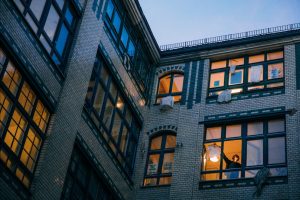At the heart of Berlin-Friedrichshain, on the Warschauer Brücke, the R.A.W. represents a major cornerstone around which many of the transformative forces reshaping the figure of Berlin throughout history have rotated. Its dynamic biography started 150 years ago when its space was rearranged to first serve as the Royal Prussian Railway Workshop in 1867, connecting Berlin with Eastern Prussia. After the fall of the monarchy in 1918 and the restoration of the Third Reich in 1933, the site was renamed Reichsbahnausbesserungswerk (National Railway Repair Works). However, its function as a crucial industrial junction in the German infrastructure underwent several damages during the Second World War, as around 80% of the area was destroyed by air raids. The industrial plants were partly restructured under the GDR regime, although they were progressively abandoned and shut down throughout the 1990s due to an over-supply of maintenance facilities reached after the fall of the Wall. The R.A.W. gradually turned into another unappealing wasteland characterizing the post-unification Berlin landscape.
It was not before 1999 that its status as a disused workspace was creatively reinterpreted as a potential resource to be exploited by artists and other cultural producers of the newly formed RAW-Tempel association, which appropriated the remaining buildings as a temporary creative site. From this first input, new forms of initiatives directed at professional artists as well as at local communities began to be established, re-orienting the developmental trajectory of the R.A.W. towards its original role as a lively node of exchange, this time allowing the connection of people and ideas. Indeed, the main purpose of the project subsuming the whole range of commercial and non-profit activities present in the R.A.W. was – and still is – to generate a high-quality but easily accessible culture, that has slowly affirmed the site as a plastic, versatile, and dynamic reality where a mosaic of heterogeneous projects might harmonically coexist and a multifaceted social fabric might flourish.
However, the lack of contact with the private investor who owned the place from 2007 to 2015 led to several issues. The owner, in fact, was not showing any interest in supporting the R.A.W.’s activities, nor in improving the conditions of its infrastructures. Thus, informal users and tenants had to sort out alternative solutions to cover running costs, such as temporarily sub-leasing parts of the overall complex. Nevertheless, the fact that clear and institutionalized management competencies were missing paved the way for growing criminality within the R.A.W.’s borders, raising general concerns among residents and occasional visitors.
In 2015, the ownership of the R.A.W. was acquired by the Kurth Group, which gained control over the largest (52,000 square meters) and still mostly not built area of the former industrial lot. Displaying great potential for investment and experimentation with the urban space, the R.A.W. site was immediately included in plans for development. Workshops were organized and proposals were carefully evaluated to find the optimal compromise between the strive for urban renovation and the identitarian challenges imposed by the users’ symbolic experience of the R.A.W. as one of the last examples of dismissed industrial installments that have, so far, escaped gentrification.
The Kurth Group has firmly underscored its intention to respect and leave unchanged the nature of the R.A.W. and the fundamental values along which its socio-cultural program is structured. In particular, the densely built area belonging to the so-called Soziokulterelle L (the L-shaped buildings harboring the major (sub)cultural players in the R.A.W.) was granted independence by allowing its residents to sign a 30-year-long and rent-free lease on the properties, giving them complete authority over the determination of the use of space. Moreover, the establishment of an open channel of communication was encouraged, so that informal users and long-term tenants are actively included in deliberative processes of decision-making concerning the development of the R.A.W. and its desired functions within the future cityscape.
Negotiations have recently reached an end for the construction of the R.A.W. Tower, a 100-meter-tall building whose realization will start in 2024 and will be completed within 10-15 years. The project plan is conceived, at least formally, to respect ideas of space versatility and creativity, merging plastically with pre-existing activities: offices will be built alongside publicly-available green areas, covered markets, and other services benefitting the urban surroundings and local communities. Thus, while organizational and structural interventions were advanced to improve the success of its commercial apparatus, the R.A.W. could maintain its former role as a key institution within the district of Friedrichshain-Kreutzberg, providing communities with varying opportunities for consuming culture, networking, and experimenting with the different uses an urban space can be assigned to, e.g., realizing intercultural projects, enjoying food, hosting exhibitions, local markets, bars, and clubs.
Nevertheless, some suspicions might arise from such a collaborative narrative of harmonious integration, synergy, and mutual accountability between the different actors involved in the R.A.W. project. Notwithstanding the participatory approach undertaken to deal with issues of urban development, residents, tenants, and local politicians are well aware of their position of power within the field of relational forces established by the real estate market in Berlin and the realization of another skyscraper in the heart of Friedrichshain-Kreutzberg raises doubts on whether locals would have opted for the R.A.W. Tower having been investors absent. Ultimately, the public accessibility of the new R.A.W. spaces will be assessed just as the project goes through its implementation.
Tesserae used the long story of the informal neighborhood development of the R.A.W. as a research subject, focusing on it from 2002 to 2010. Our collaborator Michael Rostalski, involved in the Ideenaufruf / Call for Ideas – Action-research Program, produced a written report on the R.A.W. (Gelebte Orte – Geplante Stadt: Das Raw-Gelände in Berlin. Informelle Nutzung urbaner Räume und partizipative Stadtentwicklung, published by Verlag Koenigshause) as a compelling case showing how participation and inclusion within urban development planning might be approached.
Link & Download
Further information:
News articles on Berliner Woche; Berliner Zeitung; Taz


